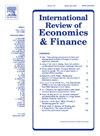Can we better predict financial crisis? The role of Laplacian-energy-like measure
IF 4.8
2区 经济学
Q1 BUSINESS, FINANCE
引用次数: 0
Abstract
How to accurately and effectively predict financial crisis is one of the crucial and challenging issues in the field of financial risk management. A great number of financial crisis prediction paradigms are strictly limited to macroeconomic indicators, ignoring potential network effects, and the drawbacks are actually obvious. This paper aims to propose early warning models with a novel network topological indicator, the Laplacian-energy-like measure (LEL), to deal with this issue. We construct a series of monthly stock networks of Chinese A-shares and extract the LEL. Then, with the help of the prediction methods of machine learning and ensemble learning, we establish new early warning models involving LEL. Furthermore, we formulate and implement a comprehensive validation strategy to evaluate the predictive performance of our proposed models. Compared with the traditional models with alternative indicators such as network density and investor sentiment index, our proposed models demonstrate the outstanding characteristics of higher scores on the area under the curve, F1-score, accuracy and recall. In addition, by utilizing the Shapley value approach to assess the importance of predictors across diverse early warning models, LEL consistently ranks top two among predictive factors. Finally, the robustness of our proposed models with LEL are further confirmed in the US stock market.
我们能更好地预测金融危机吗?拉普拉斯类能测度的作用
如何准确有效地预测金融危机是金融风险管理领域的关键和具有挑战性的问题之一。大量的金融危机预测范式严格局限于宏观经济指标,忽视了潜在的网络效应,其弊端实际上是显而易见的。为了解决这一问题,本文提出了一种新的网络拓扑指标——拉普拉斯类能测度(Laplacian-energy-like measure, LEL)预警模型。我们构建了一系列中国a股的月度股票网络,并提取了LEL。然后,借助机器学习和集成学习的预测方法,我们建立了新的涉及LEL的预警模型。此外,我们制定并实施了一个全面的验证策略来评估我们提出的模型的预测性能。与具有网络密度和投资者情绪指数等替代指标的传统模型相比,我们提出的模型在曲线下面积、f1得分、准确率和召回率方面表现出较高的特点。此外,通过利用Shapley值方法评估不同预警模型中预测因子的重要性,LEL在预测因子中始终排名前两位。最后,在美国股市中进一步验证了LEL模型的鲁棒性。
本文章由计算机程序翻译,如有差异,请以英文原文为准。
求助全文
约1分钟内获得全文
求助全文
来源期刊
CiteScore
7.30
自引率
2.20%
发文量
253
期刊介绍:
The International Review of Economics & Finance (IREF) is a scholarly journal devoted to the publication of high quality theoretical and empirical articles in all areas of international economics, macroeconomics and financial economics. Contributions that facilitate the communications between the real and the financial sectors of the economy are of particular interest.

 求助内容:
求助内容: 应助结果提醒方式:
应助结果提醒方式:


